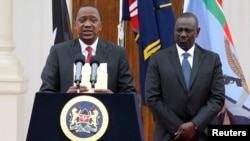Two top Kenyan security officials are being replaced following a terrorist attack that left 36 people dead Tuesday in northeastern Kenya, the second such incident in 10 days.
Kenya's president announced the changes, while vowing to intensify Kenya's war on terrorism.
In an address to the nation, President Uhuru Kenyatta said he accepted the resignation of Police Chief David Kimaiyo and has nominated a new Cabinet Secretary for Interior - to replace Joseph Ole Lenku.
The changes came after gunmen attacked workers from a quarry in Mandera County, near the border with Somalia, as they slept in their tents, an attack claimed by the Somali militant group al-Shabab.
Last week, militants hijacked a bus in a nearby area, killing 28 people. In both incidents, witnesses say non-Muslims were separated and executed.
In his address, Kenyatta tried to deflect the growing criticism of his government's handling of the security situation in the country.
“Kenya is at war and our enemy thrives on sowing panic and despondency in our hearts. We aid this enemy when we succumb to suspicion, fear, finger-pointing and blame games,” said Kenyatta.
Kimaiyo retires
At a news conference, police chief Kimaiyo said he was taking early retirement for personal reasons. No successor has been named. Kenyatta announced he was nominating Major General Joseph Nkaissery to replace Ole Lenku.
Al-Shabab Timeline
Al-Shabab Timeline2006 - Launches insurgency to take control of Somalia and impose strict Islamic law
2008 - U.S. declares al-Shabab a foreign terrorist organization
2009 - Seizes control of parts of Mogadishu and the port city Kismayo
2010 - Expands control across central and southern Somalia, carries out deadly bombing in Kampala, Uganda
2011 - Blocks drought/famine aid from areas under its control
2011 - East African leaders declare al-Shabab a regional threat; Ethiopian, Kenyan troops enter Somalia to pursue the group, which is driven out of Mogadishu
2012 - Declares itself an al-Qaida ally, loses ground in Somalia, abandons strategic coastal stronghold Kismayo
2013 - Attacks Mogadishu court complex, killing more than 30 and attacks mall in Nairobi, Kenya, killing at least 69 people
2014 - Attack in Mogadishu kills more than 10 on New Year's Day
Activists called for both officials to step down during recent protests in Nairobi, demanding better security following several terror attacks in Kenya. The most notable was last year's deadly siege on the Westgate Shopping mall, also claimed by al-Shabab.
President Kenyatta called for Kenyans to support the war on terrorism and continued military involvement in Somalia, al-Shabab’s base.
“We will not flinch or relent in the war on terrorism in our country and our region. We shall continue to inflict painful casualties on these terrorists until we secure our country and region,” said Kenyatta.
Al-Shabab claims responsibility
In a statement sent to the media, an al-Shabab spokesman said the group's Saleh Naban brigade carried out Tuesday's attack as part of a continuing response to “Kenya's occupation of Muslim lands.”
Kenyan Defense Forces have been active in Somalia since 2011. Last week, Kenyan jets targeted militant bases across the border in response to the bus attack.
A KDF spokesman told VOA Kenya forces already in the area are conducting “active operations” in pursuit of those responsible for Tuesday's attack on quarry workers.









